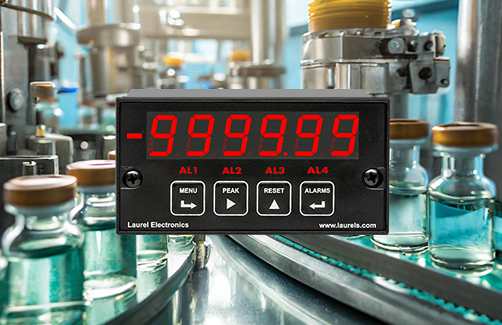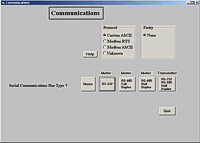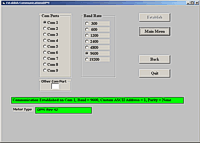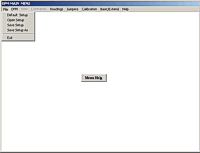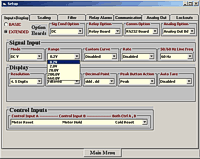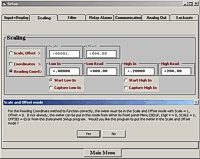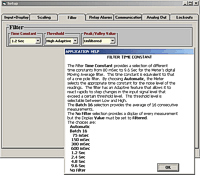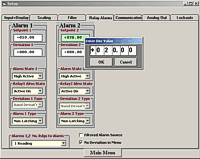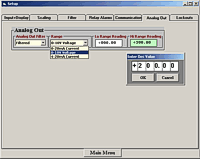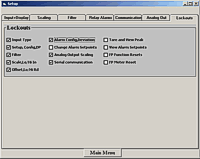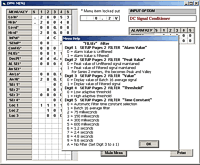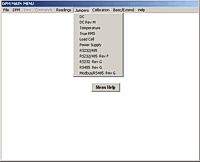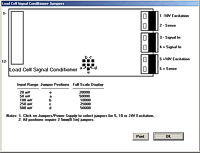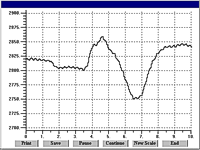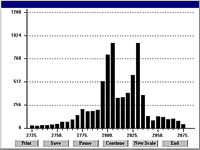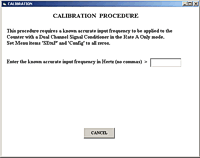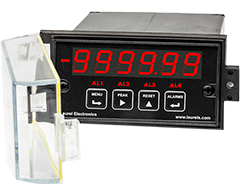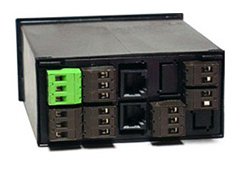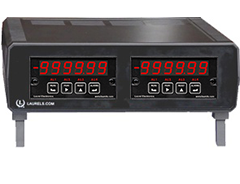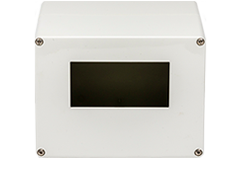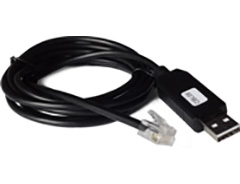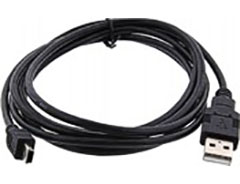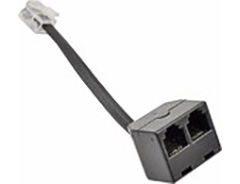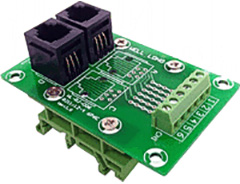- Description
- Specifications
- Setup Software
- Mechanical
- Documents
- Applications
- Technical FAQ
- Accessories
Features
- Provides automatic control for repetitive liquid fill operations
- Available for turbine flow meter pulse signals from 0 Hz to 1 MHz or analog flow meter signals (4-20 mA, 0-1 mA or 0-10V)
- 6-digit scalable display to ±999,999 for batch total, grand total, number of batches, or flow rate
- Counts up from 0 to preset or down from preset to 0
- Two or four control relays for with settable delay between cycles
- All input ranges are user selectable and factory calibrated
- Digital span adjustment: 0 to ±999,999; zero adjustment: -999,999 to +999,999
- Front panel scalable: 0 to ±999,999 for use with current shunts
- 1/8 DIN size with bright red or green 0.56" (14.2mm), high LED digits
- Transducer excitation output, 5, 10, 12, or 24 Vdc (isolated)
- Power 85-264 Vac / 90-300 Vdc or 10-48 Vdc / 12-32 Vac (isolated)
- Operating temperature from -40°C to 70°C (-40°F to 158°F)
- Wide choice of Plug-in-Play options:
- 2 or 4 relays, mechanical or solid state, for alarm or control (isolated)
- 1 or 2 Analog output, 4-20 mA, 0-20 mA, 0-10V, or -10V to +10V (isolated)
- Communications: Ethernet, WiFi, USB, RS232, RS485 (isolated)
The Laureate™ 1/8 DIN Digital Panel Meter batch controller
is a low cost, powerful and highly accurate batching controller for repetitive fill operations. It can use the Laureate V-to-F analog signal conditioner for use with 4-20 mA, 0-1 mA or 0-10V conditioned flow meter signals. Relay control can be provided by two or four 8A contact relays, or by two or four 120 mA AC/DC solid state relays. Fill operations are repeated continually with a programmable delay from 10 ms to 199.99 sec, or based on an external control input.Three items are tracked by the batch control software. These can each be scaled to engineering units of total or flow rate and displayed by the controller's six-digit LED display: Item #1 is the current batch total, which can be set up to count up from zero to a preset limit, or down from a preset limit to zero. Item #2 can be assigned to grand total or number of batches. Item #3 is the flow rate.
Laureate Digital Panel Meters are easily programmed with Laurel’s free Instrument Setup Software, downloadable from our website and compatible with Windows PCs, requiring a data interface board for setup.
All signal conditioner board ranges are factory-calibrated, with calibration factors for each range securely stored in an onboard EEPROM. These factors can be scaled via software to accommodate external shunts, enabling field replacement of signal conditioner boards without necessitating recalibration of the associated digital panel meter. For optimal accuracy, factory recalibration is recommended annually. All Laurel Electronics instruments undergo factory calibration using the industry-leading Fluke calibrators, which are recalibrated yearly and certified traceable to national standards, ensuring the highest level of precision and reliability.
Two or four relays can be used. Relay #1 is assigned to batch total to control the filling operation. Relays #2, #3 and #4 can each be assigned by the user to Items #1, #2 or #3. For example, Relay #2 can be assigned to Item #1 (batch total) with a lower setpoint to serve as a pre-warn and slow down the fill rate near the batch setpoint, and Relay #3 can be assigned to the total number of batches to terminate the batching when a present number of bottles have been filled.
An optional serial communications board allows the batch controller to transmit Items #1, #2 and #3, as well as peak for item #3 (rate). If required, all four items can be displayed simultaneously by augmenting the batch controller with up to three Laureate remote displays. Each of these can have its own analog output and relays for alarm or control.
Batch Control with Conditioned Flow Signals
The analog input batch controller utilizes the Laureate VF voltage-to-frequency converter signal conditioner board, which converts 4-20 mA, 0-1 mA or 0-1V conditioned flow meter signals to a frequency from 10 kHz to 110 kHz. This allows the counter controller to totalize flow, to count up to a preset value, or to count down to zero from a preset value for batch control. One of the relays is dedicated to On/Off batch control, while the other relay is available to slow down rate near the setpoint or to provide another alarm or control function based on rate or total.
- An unfiltered selection provides true peak and valley readings and aids in control applications.
- A batch average filter selection averages each 16 conversions.
- An adaptive moving average filter selection provides a choice of 8 time constants from 80 ms to 9.6 seconds. When a significant change in signal level occurs, the filter adapts by briefly switching to the shortest time to follow the change, then reverts back to its selected time constant. An Auto setting selects the time constant selection based on signal noise.
Peak and valley values are automatically captured. These may be displayed via a front panel pushbutton command or control signal at the rear connector, or be transmitted as serial data.
Two rear panel control Inputs (CMOS/TTL levels, logic 0 = tied to digital ground, logic 1 = open) or dry contacts that can be set to control / activate 14 meter commands.
An (isolated) 5, 10, 12, or 24 Vdc excitation output is standard to power transducers or two-wire transmitters. Ratiometric operation, which automatically compensates for changes in the applied excitation, is jumper selectable for applications, such as bridges, where the signal to be measured is proportional to the excitation level.
Modular Design for Maximum Flexibility at Minimum Cost
All boards are isolated from meter and power grounds. Optional Plug-in-Play boards for communications and control include Ethernet, WiFi, serial communication boards, dual or quad relay boards, and an analog output board. Laureates may be powered from 85-264 Vac or optionally from 12-32 Vac or 10-48 Vdc. The display is available with bright red or green 0.56" (14.2mm) high LED digits. The 1/8 DIN case meets NEMA 4X (IP65) specifications from the front when panel mounted. Any setup functions and front panel keys can be locked out for simplified usage and security. A built-in 5, 10, 12, or 24 Vdc excitation supply can power transducers, eliminating the need for an external power supply. All power and signal connections are via UL / VDE / CSA rated screw clamp plugs.
The Laureate™ Series features modular design with up to 7 isolated plug-in boards, applicable to all Laureate 1/8 DIN Digital Panel Meters.

Modular Hardware
The design of the Laureate™ Series is modular for maximum flexibility at minimum cost. All boards are isolated from meter and power grounds. The base configuration for a panel meter or counter consists of a main module (with computer and plug-in display boards), a power supply board, and a signal conditioner board. Optional plug-in-play boards include an isolated setpoint controller board, an isolated analog output board, and an isolated digital interface board. Modular design and a choice of plug-in options allow the Laureate to be customized for a broad range of applications from simple monitoring to control and computer interface. There can be up to five plug-in boards in a 1/8 DIN Laureate.

| Display | |
|---|---|
| Readout | 6 LED digits, 7-segment, 14.2 mm (.56"), red or green |
| Display Range | -999,999 to +999,999, XXXXEX scientific notation beyond 999,999 |
| Zero Adjust | -999,999 to +999,999 |
| Span Adjust | 0 to ±999,999 |
| Indicators | Four LED lamps |
| Analog Input (V-to-F signal conditioner) | |
| Signal Types | 0-1 mA, 4-20 mA, 0-10V |
| Conversion Technique | Inverse period applied to 10 kHz- 110 kHz |
| Update Rate | 50 ms (max) |
| Gate Time | Selectable 10 ms to 199.99 s |
| Recalibration: All ranges are calibrated at the factory. Recalibration is recommended every 12 months. | |
| Power Supply Boards (one required) | |
| Voltage, standard | 85-264 Vac or 90-300 Vdc |
| Voltage, optional | 12-32 Vac or 10-48 Vdc |
| Frequency | DC or 47-63 Hz |
| Power consumption | 1.2W @ 120 Vac, 1.5W @ 240 Vac, 1.3W @ 10 Vdc, 1.4W @ 20 Vdc, |
| (typical, base meter) | 1.55W @ 30 Vdc, 1.8W @ 40 Vdc, 2.15W @ 48 Vdc |
| Power Isolation | 250V rms working, 2.3 kV rms per 1 min test |
| Excitation Output (standard) | |
| 5 Vdc | 5 Vdc ± 5%, 100 mA (jumper selectable) |
| 10 Vdc | 10 Vdc ± 5%, 120 mA (jumper selectable) |
| 12 Vdc | 12 Vdc ± 5%, 100 mA (jumper selectable) |
| 24 Vdc | 24 Vdc ± 5%, 50 mA (jumper selectable) |
| Output Isolation | 50 Vdc from signal ground |
| Analog Output Boards (one optional) | |
| Output Levels | 4-20 mA, 0-20 mA, 0-10V, -10 to +10V (single-output option) |
| Current compliance | 4-20 mA, 0-20 mA, 0-10V (dual-output option) |
| Voltage compliance | 2 mA at 10V ( > 5 kΩ load) |
| Scaling | 12V at 20 mA ( < 600 Ω load) |
| Resolution | Zero and full scale adjustable from -99999 to +99999 16 bits (0.0015% of full scale) |
| Isolation | 250V rms working, 2.3 kV rms per 1 min test (dual analog outputs share the same ground) |
| Relay Output Boards (one required for batch control) | |
| Dual magnetic relays | 2 Form C, 10A max, 440Vac or 125Vdc max, 2500VA or 300W |
| Quad magnetic relays | 4 Form A (NO), 10A max, 440Vac or 125Vdc max, 2500VA or 300W |
| Dual solid state relays | 2 Form A (NO), AC or DC, 0V - 400V, 120Ma, 35Ohms (max at On-State) |
| Quad solid state relays | 4 Form A (NO), AC or DC, 0V - 400V, 120Ma, 35Ohms (max at On-State) |
| Relay commons | Isolated commons for dual relays or each pair of quad relays |
| Relay isolation | 250V rms working, 2.3 kV rms per 1 minute test |
| Relay latching modes | Latching or non-latching |
| Relay active modes | Active on or off, active high or low |
| Hysteresis modes | QA passband mode, split hysteresis, span hysteresis |
| Communication Boards (one optional) | |
| Board Selections | RS232, RS485 with dual RJ11 connectors, RS485 with dual RJ45 connectors, USB, High-Speed Ethernet, USB-to-RS485 gateway, High-Speed Ethernet-to-RS485 gateway, WiFi with built-in antenna plus USB & RS485, WiFi with external antenna plus USB & RS485 |
| Protocols | Laurel Custom ASCII (serial), Modbus RTU (serial), Modbus TCP (Ethernet or WiFi) |
| Digital Addresses | 247 (Modbus), 31 (Laurel ASCII), |
| Isolation | 250V rms working, 2.3 kV rms per 1 min test |
| Environmental | |
| Operating Temperature | -40°C to 70°C (-40°F to 158°F) |
| Storage Temperature | -40°C to 85°C (-40°F to 185°F) |
| Relative Humidity | 95% at 40°C, non-condensing |
| Protection | NEMA-4X (IP-65) when panel mounted |
| Signal Connections | |
 |
|
| Mechanical | |
| Enclosure | 1/8 DIN, high impact plastic, UL 94V-0, color: black |
| Mounting | 1/8 DIN panel cutout required: 3.622" x 1.772" (92 mm x 45 mm). |
| Dimensions | 4.68" x 2.45" x 5.64" (119 mm x 62 mm x 143 mm) (W x H x D) |
| Maximum panel thickness | 4.5 mm (0.18") |
| Tightening Torque - Connectors | Screw terminal connectors: 5 lb-in (0.56 Nm) |
| Tightening Torque - Pawls | Digital Panel Meter Case Pawls: 5 lb-in (0.56 Nm) |
| Weight of base meter | 210 g (7.4 oz) typical (DPM, counter, timer, 6-digit remote display) |
| Weight of option boards | 30 g (1.0 oz) typical per board (analog output, relay output, communications) |
| General | |
| Programming Methods | Four front panel buttons or via Laurel's free Instrument Setup Software, which runs on a PC under MS Windows. |
| Security | Lockout options include using the front panel buttons, the free Instrument Setup Software, or a hardware jumper. |
| Warranty | 3 years parts & labor |
| Recalibration: All ranges are calibrated at the factory. Recalibration is recommended every 12 months. | |
Free Instrument Setup Software for Series 2 Laureates
Free Downloadable Windows-based Instrument Setup (IS) software (Data Interface Board Required) for use with our programmable Digital Panel Meters, Scale Meters, Counters, Timers, Remote Displays, and Transmitters, are an easy method to set up Laureate 1/8 DIN digital panel meters, counters, timers, remote displays, and DIN-rail transmitters, as explained in the Instrument Setup Software Manual. Laureate 1/8 DIN instruments can also be set up from the front panel, as explained in their respective Owners Manuals. Instrument Setup software is of benefit whether or not the PC is connected to the instrument.
- When the PC is connected to the instrument, Instrument Setup software can retrieve the setup file from the instrument or open a default setup file or previously saved setup file from disk View Setup, then provides graphical user interface (GUI) screens with pull-down menus applicable to input, display, scaling, filtering, alarms, communications, analog output, and front panel lockouts. Fields that are not applicable to the instrument as configured are either left out or grayed out. Clicking on any item will bring up a detailed Help screen for that item. After editing, the setup file can be downloaded, uploaded to the instrument, or saved to a disk. The same setup file can then be downloaded into multiple instruments.
- When the PC is not connected to the instrument, the above GUI screens can be used to set up a virtual instrument. The setup file can then be saved to disk. Switching toView Menu then brings up a screen with the required front panel programming steps. This view can be printed out for use at the instrument site and to serve as a hard copy record.
Download Free Instrument Setup Software
Installation
Set User Account Control (UAC) of MS Windows to "Never notifiy me" so that Instrument Setup Software can create directories. The UAC change screen can be reached as follows:
- Under Windows 7, click on the Windows Start button in the lower left of the desktop and enter "UAC" in the search field.
- Under Windows 8, navigate to Control Panel, then to the "User Accounts and Family Safety" section, and click on "Change User Account Control Settings."
- Under Windows 10, click on the Windows Start button in the lower left of the desktop, then on "Settings", and enter "UAC" in the search field.
- Reboot your computer for the changed UAC setting to take effect.

RJ11-to-DB9 cable with rear view of DB9 connector to PC

RS232 cable, meter to PC, P/N CBL01
Laureate 1/8 DIN Laureate instruments must be equipped with a serial communications board and be connected to the computer via a serial communications cable. The connection can be via RS232, RS485, USB or Ethernet. Following setup, the serial communications board may be removed from the instrument if desired. The wiring of the RS232 cable is illustrated above with end views of the two connectors.
Laureate LT Series transmitters come standard with a 3-wire serial interface, which can be jumpered for RS232 or RS485.
Laureate LTE Series transmitters come standard with an Ethernet interface.
Meter Setup Screens
Click on any of the reduced screens below for a full-size screen view, then click on the Back button of your browser to return to this page. The screens examples below are for a fully-loaded Series 2 Digital Panel Meter (DPM), which is connected to the PC via RS232. If the meter is a Series 1 meter (pre-2007), this is sensed by the software, and somewhat different screens are brought up. Please see Series 1 setup screens.











Meter Setup Utilities




From the Main Menu, click on Readings if your PC is connected to the meter. A pull-down menu then offers three choices: List, Plot and Graph.
- List presents the latest readings in a 20-row by 10-column table. Press Pause at any time to freeze the display. This is one method to capture peak readings.
- Plot generates a plot of readings vs. time in seconds. It effectively turns the DPM-PC combination into a printing digital oscilloscope.

- Graph generates a histogram where the horizontal axis is the reading and the vertical axis is the number of occurrences of readings. The display continually resizes itself as the number of readings increases.



Laureate™ 1/8 DIN Case For Laureate Digital Panel Meters, Counters, Timers & Remote Displays

Key Features
- Meets 1/8 DIN Standard.
- Installs from front of panel.
- Short depth behind the panel: only 4" (102 mm) plus connectors.
- Understated 0.157" (4 mm) thick bezel.
- Meets NEMA 4X (IP-65) for high-pressure wawshdon when panel mounted.
- Screw clamps connectors meet VDE / IEC / UL / CSA safety standards.
- Rugged GE Lexan® housing material.
- Safety certified per EN 61010-1.
Dimensions

Maximum panel thickness: 4.5 mm (0.18")
Weight of base meter: 210 g (7.4 oz) typical (DPM, counter, timer, 6-digit remote display)
Weight of option boards: 30 g (1.0 oz) typical per board (analog output, relay output, communications)
Tightening Torque - Connectors: Screw terminal connectors: 5 lb-in (0.56 Nm)
Tightening Torque - Pawls: Digital Panel Meter Case Pawls: 5 lb-in (0.56 Nm)
Dimensioned CAD assembly drawings in EPRT, STEP, x_t. dwg, pdf file formats: Laureate-meter-case.zip (zipping prevents browser from opening CAD files as text files).
Panel Mounting
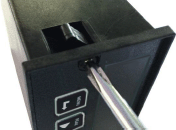 Slide the meter into a 45 x 92 mm 1/8 DIN panel cutout. Ensure that the provided gasket is in place between the front of the panel and the back of the meter bezel.
The meter is secured by two pawls, each held by a screw, as illustrated. Turning each screw counterclockwise extends the pawl outward from the case and behind the panel. Turning each screw clockwise further tightens it against the panel to secure the meter.
Slide the meter into a 45 x 92 mm 1/8 DIN panel cutout. Ensure that the provided gasket is in place between the front of the panel and the back of the meter bezel.
The meter is secured by two pawls, each held by a screw, as illustrated. Turning each screw counterclockwise extends the pawl outward from the case and behind the panel. Turning each screw clockwise further tightens it against the panel to secure the meter.
Turning each screw counterclockwise loosens the pawl and retracts it into its well. This position allows installed meter to be removed from their panel, or new meters to be installed in a panel. Do not remove the screws from their pawls. Doing so would cause the screw and pawl to fall off and likely get lost. Do not overtighten so as not to damage the plastic parts.
| Drum Filling Application Utilizing Two Relay Outputs | |
|---|---|
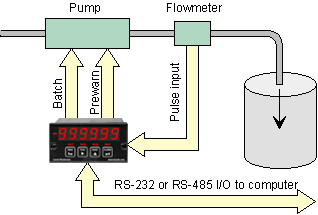 |
In this drum filling application, the Laureate pulse-input batch controller utilizes uses its two relays to control a pump. The Prewarn relay slows down the pump near the preset to avoid overshoot. The Batch relay stops the pump at the preset. |
| Controlling Chemical Mixing of Materials | |
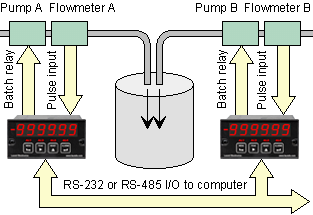 |
Multiple Laureate batch controllers can be used in combination to control the mixing of materials in the proper ratio. Each feed line is equipped with its own pump, flowmeter, and Laureate. Controller setup and monitoring of the mixing operation are facilitated by optional serial communications. RS485 allows a single data line to handle multiple controllers. |
| Up-Counting Batch Control | |
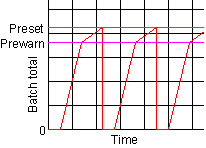 |
In up-counting batch control, the Laureate counts up from zero to a preset maximum. A prewarn level is available to slow down filling near the preset to avoid overshoot. A time delay can be programmed from the end of each batch to the start of the next batch. |
| Down-Counting Batch Control | |
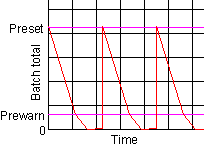 |
In down-counting batch control, the Laureate counts down from the preset maximum to zero. A prewarn level is available to slow down filling or emptying near zero. Again, a time delay can be programmed from the end of each batch to the start of the next batch. |
| Discrete Filling and Batch Counting | |
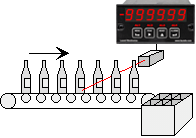 |
The Laureate batch controller is ideal for discrete manufacturing as well as repetitive fill operations. In this example, the Laureate counts bottles which it then groups into sixpacks. Its Grand Total capability can be used to track bottles or sixpacks. |
Batch Controller Digital Panel Meter Frequently Asked Technical Questions
IPC
Splashproof Cover
CLB01
RS232 Cable for Meters
CLB02
USB-to-RS232 Adapter Cable
CBL04
RS232 Cable for LT Transmitters
CLB05
USB Data Cable for Meters
CLB06
USB-to-RS485 Adapter Cable
CLB07
USB Programming & Data Cable
CLB08
RS485 Splitter Cable
BKBD
RS485 RJ11 Terminal Block Adapter
1/8 DIN Panel Meter for Batch Controller Pulse Input
What is a 1/8 DIN Panel Meter for Batch Controller Pulse Input?
A 1/8 DIN Panel Meter is a compact, standardized instrument designed for precise monitoring and control of process variables in industrial and commercial settings. The "1/8 DIN" designation refers to its size, standardized by the Deutsches Institut für Normung (DIN), the German Institute for Standardization. With front panel dimensions of approximately 96mm x 48mm (3.78 inches x 1.89 inches), this meter is ideal for panel installations where space is limited yet high functionality is required.
When configured as a batch controller with pulse input, this Panel Meter is tailored to manage batch processes by interpreting pulse signals, ensuring accurate dispensing of materials like liquids, powders, or granules. This section provides a comprehensive overview of its functionality, features, and applications.
Understanding a Panel Meter
A Panel Meter is an electronic device that processes input signals from sensors, transducers, or process equipment and displays the corresponding measurements on a digital screen. These inputs can include voltage, current, resistance, temperature, frequency, or pulses, depending on the application. The 1/8 DIN Panel Meter for batch control excels at handling pulse inputs, making it a critical tool for automating precise material dispensing.
Batch Controllers: Role and Functionality
Batch controllers are specialized devices used in process automation to regulate the exact quantity of material dispensed into a container or process, such as during filling, dosing, or mixing operations. By ensuring consistent batch sizes, these controllers minimize waste, enhance product quality, and improve operational efficiency. A 1/8 DIN Panel Meter with batch controller functionality automates these tasks by counting pulses and triggering actions based on preset parameters.
Pulse Input: How It Works
Pulse input refers to the method by which the Panel Meter receives data, with each pulse representing a specific quantity or event. Common sources of pulse signals include:
- Flow Meters: Each pulse corresponds to a fixed volume of liquid or gas passing through the meter.
- Tachometers: Pulses indicate revolutions of a motor shaft or other rotating components.
- Counters: Pulses track discrete events, such as items passing on a conveyor.
The 1/8 DIN Panel Meter processes these pulses, converting them into meaningful measurements like total volume, batch count, or flow rate, displayed on its digital screen for real-time monitoring and control.
How Does a 1/8 DIN Panel Meter for Batch Controller Pulse Input Work?
The operation of this Panel Meter involves several key steps to ensure precise batch control:
-
Pulse Signal Acquisition: The meter receives pulse signals from sensors, such as flow meters or encoders, connected to its input terminals.
-
Signal Processing: Internal electronics count and process the pulses, scaling them to represent specific units (e.g., liters, units, or revolutions) based on user-defined settings.
-
Batch Control: The meter compares the accumulated pulse count to a preset batch setpoint, triggering outputs (e.g., relays) to start, stop, or adjust the dispensing process when the target is reached.
-
Display and Feedback: Real-time data, such as current batch count, total volume, or flow rate, is shown on the digital display, providing operators with clear insights.
-
Integration: The meter supports communication interfaces (e.g., RS-232, RS-485) and output options, enabling integration with PLCs, SCADA systems, or other control equipment.
Key Features of a 1/8 DIN Panel Meter for Batch Controller Pulse Input
-
Compact Design: The 1/8 DIN size optimizes space in control panels, making it suitable for applications with spatial constraints.
-
Pulse Signal Compatibility: Engineered to handle pulse inputs from various sensors, this meter is ideal for flow measurement, counting, and speed monitoring tasks.
-
Accurate Measurement: High-precision pulse counting ensures reliable batch control, minimizing errors in material dispensing.
-
Programmable Functions: Features like setpoints, alarms, and relay outputs allow customizable control, adapting to specific batch requirements.
-
User-Friendly Interface: A clear digital display and intuitive controls enable operators to easily configure and monitor batch parameters.
-
Industrial-Grade Durability: Built to withstand harsh environments, the meter offers robust performance and long-term reliability.
Applications of a 1/8 DIN Panel Meter for Batch Controller Pulse Input
- Manufacturing: Precise dispensing of raw materials in production lines for consistent output.
- Water Treatment: Accurate dosing of chemicals or water in treatment processes.
- Food and Beverage: Uniform batching of ingredients for quality and compliance.
- Pharmaceuticals: Exact dosing in drug production for safety and efficacy.
- Petrochemicals: Controlled batching of fuels or chemicals for efficiency.
- Packaging: Consistent filling of containers to reduce waste.
- Energy Management: Monitoring and controlling energy distribution with precision.
Where Is a 1/8 DIN Panel Meter for Batch Controller Pulse Input Used?
A 1/8 DIN Panel Meter with batch controller and pulse input is a powerful tool for process automation, offering precise control over material dispensing in various industrial and commercial applications. Below, we explore key industries and use cases where this device is commonly deployed.
1. Industrial Manufacturing
In manufacturing, precise control over material dispensing is essential for maintaining product quality and efficiency. This Panel Meter manages batch processes by counting pulses from flow meters or sensors, ensuring accurate quantities of liquids, powders, or components are dispensed. For example, in a bottling plant, it controls the volume of liquid filled into each bottle, enhancing consistency and minimizing waste.
2. Chemical Processing
Chemical plants require exact measurement and control of ingredients to ensure product consistency and safety. The 1/8 DIN Panel Meter regulates chemical dosing by interpreting pulse inputs from flow sensors, delivering precise quantities for mixing processes. This accuracy prevents costly errors, improves product quality, and ensures compliance with safety standards.
3. Water Treatment Facilities
Water treatment plants rely on accurate chemical dosing to maintain water quality. This Panel Meter controls the addition of chemicals like chlorine or fluoride by counting pulses from flow meters, ensuring the correct dosage relative to water flow. Its batch control capabilities support regulatory compliance and efficient treatment processes.
4. Food and Beverage Industry
In the food and beverage sector, precision in batching ingredients is critical for quality and regulatory compliance. The 1/8 DIN Panel Meter ensures consistent dispensing of ingredients, such as liquids or powders, during production. For instance, in a bakery, it controls dough portions for uniform product size and weight, enhancing customer satisfaction.
5. Pharmaceutical Manufacturing
Pharmaceutical production demands stringent control over ingredient quantities to ensure drug safety and efficacy. This Panel Meter manages precise dosing by processing pulse inputs from high-accuracy flow meters, ensuring each batch meets exact specifications. Its reliability is vital for maintaining compliance with strict regulatory standards.
6. Petrochemical Industry
In the petrochemical sector, handling volatile and costly materials requires precision. The 1/8 DIN Panel Meter controls batching of fuels, lubricants, or chemicals by counting pulses from flow sensors, ensuring accurate distribution. This precision reduces waste and supports efficient resource management.
7. Packaging Industry
The packaging industry demands accurate filling of containers to meet product specifications and reduce waste. This Panel Meter regulates filling machines by processing pulse inputs, ensuring each container receives the correct amount of liquid or solid product. Its batch control enhances efficiency and customer trust.
8. Energy Management Systems
In energy management, particularly for power or resource distribution, precise measurement is critical. The 1/8 DIN Panel Meter monitors and controls energy or material flow by counting pulses from meters or sensors, ensuring efficient distribution aligned with system requirements.
Conclusion
A 1/8 DIN Panel Meter for batch controller pulse input is an essential tool in process automation, delivering precise control and monitoring for batch processes. Its compact design, compatibility with pulse signals, and programmable features make it ideal for a wide range of applications, from manufacturing and chemical processing to food production and energy management. By improving efficiency, reducing waste, and ensuring consistent quality, this Panel Meter is a cornerstone of modern industrial operations.
Less Information.








